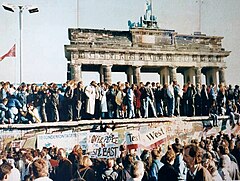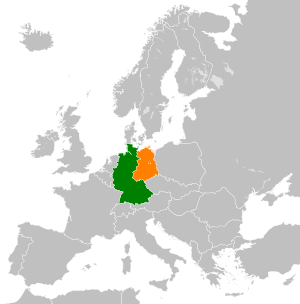| Part of the Revolutions of 1989 and the end of the Cold War | |
 Germans stand on top of the Wall in front of the Brandenburg Gate in the days before the Wall was torn down. | |
| Native name | Deutsche WiedervereinigungDie Wende |
|---|---|
| Date | 9 November 1989 – 3 October 1990 |
| Location | |
| Cause | Revolutions of 1989 |
| Outcome | Reunification of Germany under the Federal Republic
|


German reunification (German: Deutsche Wiedervereinigung) was the process of re-establishing Germany as a single sovereign state, which began on 9 November 1989 and culminated on 3 October 1990 with the dissolution of the German Democratic Republic and the integration of its re-established constituent federated states into the Federal Republic of Germany to form present-day Germany. This date was chosen as the customary German Unity Day, and has thereafter been celebrated each year as a national holiday in Germany since 1991.[1] On the same date, East and West Berlin were also reunified into a single city, which eventually became the capital of Germany.
The East German government, controlled by the Socialist Unity Party of Germany (SED), started to falter on 2 May 1989, when the removal of Hungary's border fence with Austria opened a hole in the Iron Curtain. The border was still closely guarded, but the Pan-European Picnic and the indecisive reaction of the rulers of the Eastern Bloc set in motion an irreversible movement.[2][3] It allowed an exodus of thousands of East Germans fleeing to West Germany via Hungary. The Peaceful Revolution, part of the international revolutions of 1989 including a series of protests by East German citizens, led to the fall of the Berlin Wall on 9 November 1989 and the GDR's first free elections later on 18 March 1990 and then to negotiations between the two countries that culminated in a Unification Treaty.[1] Other negotiations between the two Germanies and the four occupying powers in Germany produced the Treaty on the Final Settlement with Respect to Germany, which granted on 15 March 1991 full sovereignty to a reunified German state, whose two parts were previously bound by a number of limitations stemming from their post-World War II status as occupation zones, though only on 31 August 1994 did the last Russian occupation troops leave Germany.
After the end of World War II in Europe, the old German Reich was abolished and Germany was occupied and divided by the four Allied countries. There was no peace treaty. Two countries emerged. The American-occupied, British-occupied, and French-occupied zones combined to form the FRG, i.e., West Germany, on 23 May 1949. The Soviet-occupied zone formed the GDR, i.e., East Germany, in October 1949. The West German state joined NATO in 1955. In 1990, a range of opinions continued to be maintained over whether a reunited Germany could be said to represent "Germany as a whole"[b] for this purpose. In the context of the revolutions of 1989; on 12 September 1990, under the Two Plus Four Treaty with the four Allies, both East and West Germany committed to the principle that their joint pre-1990 boundary constituted the entire territory that could be claimed by a government of Germany.
The reunited state is not a successor state, but an enlarged continuation of the 1949–1990 West German state. The enlarged Federal Republic of Germany retained the West German seats in the governing bodies of the European Economic Community (EC) (later the European Union) and in international organizations including the North Atlantic Treaty Organization (NATO) and the United Nations (UN), while relinquishing membership in the Warsaw Pact (WP) and other international organizations to which only East Germany belonged.
Cite error: There are <ref group=lower-alpha> tags or {{efn}} templates on this page, but the references will not show without a {{reflist|group=lower-alpha}} template or {{notelist}} template (see the help page).
- ^ a b "EinigVtr – Vertrag zwischen der Bundesrepublik Deutschland und der Deutschen Demokratischen Republik über die Herstellung der Einheit Deutschlands". www.gesetze-im-internet.de (in German). Archived from the original on 20 November 2022. Retrieved 6 March 2022.
- ^ Brait, Andrea; Gehler, Michael (6 July 2014), "Grenzöffnung 1989 – Offene Grenzen?", Grenzöffnung 1989, Wien: Böhlau Verlag, pp. 9–44, doi:10.7767/boehlau.9783205793236.9, ISBN 978-3-205-79496-7, retrieved 6 March 2022
- ^ Sardemann, Gerhard (1 August 2010). "Die Welt aus den Angeln heben". TATuP: Zeitschrift für Technikfolgenabschätzung in Theorie und Praxis. 19 (2): 8–17. doi:10.14512/tatup.19.2.8. ISSN 2199-9201.